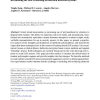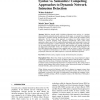9 search results - page 2 / 2 » Network-Level Polymorphic Shellcode Detection Using Emulatio... |
ML
2010
ACM
13 years 3 months ago
2010
ACM
Current trends demonstrate an increasing use of polymorphism by attackers to disguise their exploits. The ability for malicious code to be easily, and automatically, transformed in...
DIMVA
2009
13 years 5 months ago
2009
Drive-by download attacks are among the most common methods for spreading malware today. These attacks typically exploit memory corruption vulnerabilities in web browsers and brows...
IJSN
2008
13 years 4 months ago
2008
: Malicious network traffic, including widespread worm activity, is a growing threat to Internet-connected networks and hosts. In this paper, we consider two competing approaches t...
CCS
2007
ACM
13 years 8 months ago
2007
ACM
Remotely-launched software exploits are a common way for attackers to intrude into vulnerable computer systems. As detection techniques improve, remote exploitation techniques are...


